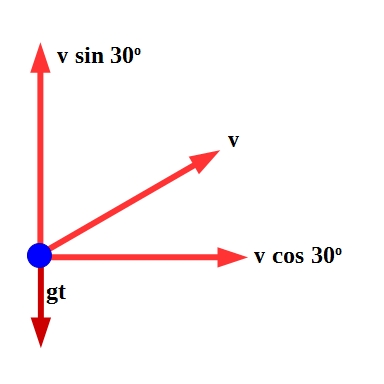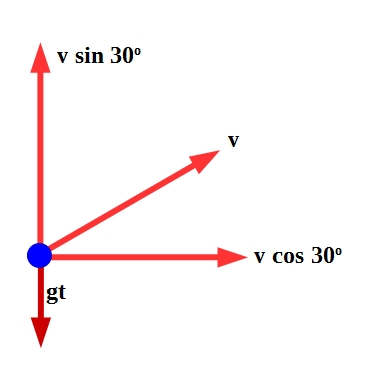
All Solutions
Page 149: Standardized Test Prep
This is the point at which the vertical velocity becomes zero.
$v cos 30^o$ is the horizontal component. From the diagram,
$v sin 30^o$ and $gt$ are vertical components but they are opposite to each other.
So the vertical velocity of the projectile is $v sin 30^o – gt$.

From the diagram, $v cos 30^o$ is the horizontal component of the velocity.

constant velocity in the other dimension.
#### Known
To add two vectors, we place the tail of the second vector on the head of the first vector. The resultant vector is the vector that goes from the tail of the first to the head of the second. Always keeping the directions of the vectors and their lengths.
Therefore, the result is option (C).
We can see this in the following figure:

$$
begin{align*}
vec{A}-vec{B}=vec{A}+(-vec{B})
end{align*}
$$
—
#### Conclusion
Option (C).
#### Known
The vertical position of a projectile can be determined with one of the following equations:
$$
begin{align}
y_f&=y_i+v_{y,i}cdot t-frac{gcdot t^2}{2}\
v_{y,f}^2&=v_{y,i}^2-2g(y_f-y_i)
end{align}
$$
From the position time graph, we have:
The time position graph gives us precisely the information of which is the vertical position (position on the $y$ axis) of the projectile for each instant of time. Therefore, from the graph we can see directly that for $t=4 tx{s}$ the height of the projectile is $40 tx{m}$. In the same way we can determine the vertical position for any other instant of time.
From the velocity time graph we can know what is the velocity (vertical) of the projectile at $t=4 tx{s}$ and also for $t=0 tx{s}$ what is its initial velocity (vertical). With this information and using equation (2), we can calculate the vertical position of the projectile at $t=4 tx{s}$.
From (2) we have:
$$
begin{align*}
y_f-y_i=frac{v_{y,f}^2-v_{y,i}^2}{-2g}
end{align*}
$$
With $v_i=30 frac{tx{m}}{tx{s}}$ at $t=0 tx{s}$. $v_f=-10 frac{tx{m}}{tx{s}}$ at $t=4 tx{s}$. $y_i=0 tx{m}$. $gapprox 10 frac{tx{m}}{tx{s}^2}$.
Therefore:
$$
begin{align*}
y_f-0 tx{m}&=frac{left(-10 frac{tx{m}}{tx{s}}right)^2-left(30 frac{tx{m}}{tx{s}}right)^2}{-2left(10 frac{tx{m}}{tx{s}^2}right)}\
y_f&=40 tx{m}
end{align*}
$$
This is the same result that is observed in the position-time graph.
—
#### Conclusion
The vertical position of the projectile can be determined directly from the position-time graph. With the velocity-time graph we need the equations of motion to determine the vertical position of the projectile.
Haven't found what you were looking for?
Search for samples, answers to your questions and flashcards

